What is Hybrid Rocket?
A hybrid rocket uses different phases of fuel and oxidizer (generally solid fuel and liquid@oxidizer) as propellants. Conventional hybrid rockets use a configuration like that shown in Figure 1. There is a hole called a port in the fuel, and combustion occurs by supplying oxidizer gas into this port. Because hybrid rockets use solid fuel, they are non-hazardous and easier to store than solid or liquid rockets, which use hazardous propellants . Hybrid rockets also have the advantages of the possibility of thrust control, low cost, simple structure and wide-spread commercial availability of propellants.
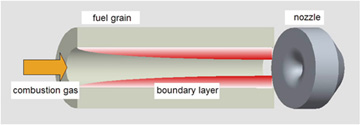 |
|
Figure 1. Conventional Hybrid Rocket
|
(1) Poor combustion efficiency due to incomplete mixing of fuel and oxidizer gas
(2) Low thrust due to low flame traveling velocity
(3) Decrease in specific impulse due to change in mixture ratio (O/F) during combustion
To overcome these defects, we develop two types of rockets: the CAMUI type Hybrid Rocket and the End-Burning type Hybrid Rocket.
CAMUI Type Hybrid Rocket
CAMUI is an abbreviation of Cascaded Multistage Impinging-jet. This represents a unique combustion method for hybrid rockets. The term was inspired by the word, gKamuyh, which is the word for gthe godsh of the native Ainu people of Hokkaido.
CAMUI fuel blocks have two ports with a short axial length as shown in Figure 2 (a). Several fuel blocks are assembled vertically in the combustion chamber as shown in Figure 2 (b). By placing ports of adjacent fuel grains 90 apart, an impinging surface for the combustion gas is formed at every block. The combustion gas supplied from the upstream of the combustion chamber passes through the ports and then impinges on the surface of the next fuel block. At this moment, combustion with impinging-jet heat transfer occurs on the impinging surface. Impinging-jet heat transfer is a phenomenon in which high heat transfer can be obtained near the stagnation point when the jet impinges on the wall surface. By taking advantage of this, the fuel surface is sufficiently heated, the gasification of the fuel is promoted, and a high regression rate can be obtained. Furthermore, the unburned gas in the combustion gas is mixed by the turbulent flow because of the impinging jet and reacts well with the oxidizer near the stagnation point. As a result, high combustion efficiency can also be obtained. Therefore, the CAMUI type hybrid rocket overcomes the disadvantages of conventional hybrid rockets, such as (1) and (2) listed above.
 |  |
|
(a)
|
(b)
|
>>top
End-Burning Type Hybrid Rocket
A fuel grain of the end-burning hybrid rocket is shown in Figure 3, a fuel grain with many small ports. In this figure, there are 433 ports that are 0.3 mm in diameter. This fuel grain can only be made by state-of-the-art 3-D printing technology. This technology enables us to research end-burning type hybrid rocket combustion for the first time.Now we are leading the study of the end-burning type hybrid rockets worldwide.
 |  |
|
Figure 3. Fuel for end burning hybrid rockets
|
|
 |
|
Figure 4. Concept of end-surface combustion hybrid rocket
|
Hybrid Kick Motor
The demand for small satellites launches has been rapidly increasing in recent years. However, the number of launch opportunities for rockets to bring satellites to space is insufficient to meet the demand for satellite launches. The mainstream method of launching small satellites is to utilize the excess the launch capacity of larger satellites, in a so-called grideshareh or gpiggy-backingh configuration. While piggybacking a satellite to space has the great advantage of being much lower in cost than launching multiple single-satellite rockets independently, it also has the disadvantage of limited launch times and injection orbits. To solve this problem, our laboratory has been researching and developing a "hybrid kick motor" that uses a hybrid rocket as the orbit-transfer thruster for small satellites after arriving in space.
Hybrid rockets are suitable kick motors for piggybacking applications because of their inherent safety and low cost.ihttps://www.isas.jaxa.jp/home/smallsat/tra-b/plan_a01.htmlj
Furthermore, for launch vehicles, it is sufficient to ignite the rocket once at launch, i.e., re-ignition is not necessary, whereas re-ignition is essential for kick motors that are used for transferring between orbits that donft intersection (e.g., Hohmann transfer, etc.), orbit insertion into orbits around other celestial bodies, or landing on gravitational bodies.
We are currently working towards a technology demonstration mission in 2023 (yet to be determined), by focusing our research and development efforts around the following topics:
1) Establishing the flexibility of solid fuel shape design to maintain high specific impulse
2) Optimum nozzle shape design based on prediction of nozzle throat erosion history
3) Establishment of nozzle materials and operating conditions that suppress nozzle throat erosion
4) Establishment of a self-pressurized oxidizer flow system
5) Establishment of kick motor re-ignition technology in space
6) Data acquisition method and dynamic analysis for 6-axis thrust measurement
7) Development of cold gas thrusters for attitude control
JAXA has launched the H2 rocket 42 times in the past 20 years, but only four of these launches have gone into deep space, from which, in 2014, Procyon is the only small satellite to have been delivered to deep space. This shows that the number of rocket launches is small, and there are few opportunities to put small satellites into orbit.
Our strategy for increasing access to deep space is to equip small satellites without our kick motor, piggyback to GTO (Geostationary Transfer Orbit), and use the kick motor to accelerate the small satellites to relative velocities of 700 m/s to 1 km/s. JAXA has already launched small satellites into GTO orbit 19 times in the past 20 years, which is more than the number of launch opportunities to deep space. By piggybacking our kick motor to GTO, we can dramatically increase the number of opportunities for deep space exploration by small satellites.
60wt% Hydrogen Peroxide-Water
In recent years, there has been an increase in the development of microsatellites with a mass of 100 kg or less, and their small size and low cost have made it possible for private companies and universities to conduct research. Nowadays, microsatellites developed for technology demonstration are launched as piggyback vehicles on large rockets. Many microsatellites are being developed for advanced missions such as for deep space exploration and earth observation. As satellites become smaller, the propulsion systems also need to become smaller. In the case of microsatellites, which are often launched together with other satellites in a piggyback configuration, orbit changes may be necessary even after the spacecraft is detached from the rocket, such as for deep space exploration. Therefore, inexpensive, safe, and compact satellite propulsion systems, referred to as kick motors, are needed.
 |
|
Figure 5. Successful ignition
|
In the past, there have been studies using hydrogen peroxide as an oxidizer, but most of them used highly concentrated hydrogen peroxide of 80wt% or higher. However, in the case of hydrogen peroxide, which is self-decomposing, the decomposition heat exceeds the latent reaction proceeds in a chain reaction, resulting in an increase in internal pressure and the risk of vessel breakage.
60wt% hydrogen peroxide is not self-degradable and is available as a commercial-off-the-shelf product. The specific impulse can be as high as 290s in a vacuum. However, 60wt% hydrogen peroxide is extremely difficult to ignite and hold a flame because most of the combustion gas is water, and there are few examples of flame holding below 80wt%. If successful in ignition and flame holding, 60wt% hydrogen peroxide could be very suitable among the oxidizers that have been used so far. Thus, we are aiming to improve ignition and flame holding by devising the following three innovations.
(1) Improved flame holding through the use of CAMUI type fuel
 |
|
Figure 6. Melting nozzle
|
A platinum catalyst was used to decompose hydrogen peroxide. The gaseous oxygen in the product was used as an oxidizer and ignition was successful.
(3) Raising combustion chamber pressure at ignition with melting nozzle
Melting nozzles are high-density polyethylene nozzles that are attached to the inside of non-melting graphite nozzle. The melting nozzle is attached to the nozzle throat to narrow the throat section area and increase the combustion chamber pressure even at low flow rate ignition. After ignition, the nozzle is melts away by the heat of the combustion gas.
In the future, we plan to conduct research on flame holding based on the previous research on ignition described above.
Re-ignition
As explained in the description of the hybrid kick motor above, re-ignition is necessary to place satellites into orbit without intersections, and explore deep space. In our laboratory, we are developing a safe re-ignition device that does not impair the safety and low cost of hybrid kick motors.
The re-ignition device (Figure 1) has a simple structure that only requires a heating element (e.g., glow plug etc.), and the solid fuel commonly used in hybrid rockets, and only a bypass line (Figure 1) is needed to be added when mounted on a hybrid rocket. The resulting ignitor is small and lightweight. Solid fuels are made by applying the technology of End-burning hybrid rockets, which have an array of many small ports through which the oxidizer flows. During combustion, the fuel regresses from the downstream end of the solid fuel. The re-igniter is operated by energizing the heating element, which becomes red hot (above 600 ), after which oxidizer is supplied to the fuel. The oxidizer passes through the small ports in the fuel and reaches downstream of the re-igniter. Downstream of the re-igniter, fuel gasified by the heating element mixes with the oxidizer to produce combustion gases close to 1000. This high-temperature gas can be supplied to the main rocket to ignite it.
 |
|
Figure 7
|
Nozzle Erosion
Nozzle erosion is the deterioration or removal of material from the nozzle throat due to a chemical reaction between the nozzle wall and the oxidizing species in combustion gas, or physical ablation (the melting and removal of material by the application of heat). This process is called "nozzle erosion" because it resembles the erosion seen in rivers. This phenomenon causes a change in the cross-sectional area of the nozzle throat, leading to a decrease in rocket performance. Nozzle erosion is more severe in hybrid rockets, which are being researched and developed in our laboratory, than in solid rockets, because there is a higher concentration of oxidizing species in the combustion gas flowing through the nozzle. Nonetheless, there have been very few experimental studies on nozzle erosion in hybrid rockets, and this has been a challenge for hybrid rockets developers.
In our own laboratory, nozzle erosion became a big problem in static firing tests of the 15kN-class CAMUI-type hybrid rocket, 2014. To solve this problem, we have been conducting research on the acquisition of nozzle erosion history using the NTRT and TTRT methods, with the aim of the mechanisms of nozzle erosion, and developing technologies for the suppression of nozzle erosion. We are now the world's leading laboratory in this field.
We continue to work towards the following objectives.
(1) Elucidate the conditions that lead to the onset of nozzle erosion.
(2) Formulate the dependencies of pressure, temperature, and gas composition
(3) Create technologies to actively suppress nozzle erosion
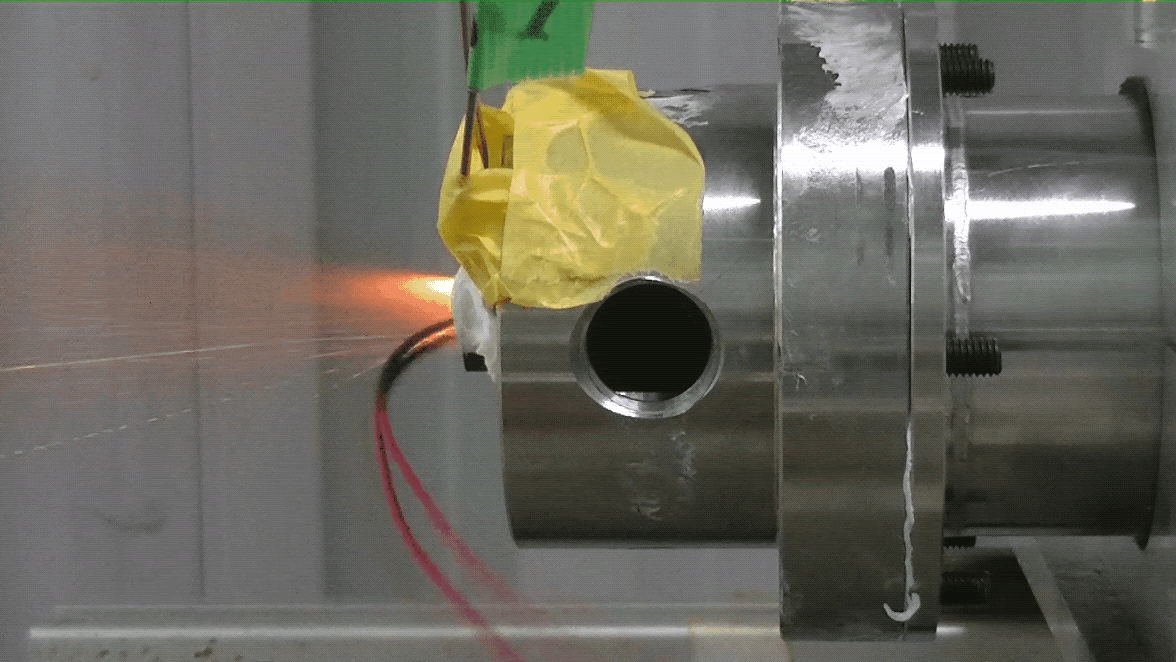 |
One of the problems in obtaining the nozzle erosion history for hybrid rockets is the O/F shift, which is a nonlinear change in the ratio of oxidizer to fuel gas flowing through the nozzle. This O/F is an important parameter that determines the amount of nozzle erosion, but the fuel gas flow rate cannot be measured directly, and it changes nonlinearly in time, thus the history of the O/F cannot be measured directly. This makes it difficult to obtain the nozzle erosion history, and analyze the causes of nozzle erosion when it occurs.
To solve this problem, we developed the Nozzle Throat Reconstruction Technique (NTRT), an algorithm to obtain the time history of O/F, even when nozzle erosion occurs, from five measurable values: (1) combustion chamber pressure, (2) thrust, (3) oxidizer flow rate, (4) fuel consumption, and (5) nozzle diameter after combustion. We also developed the TTRT (Throat-Temperature Reconstruction Technique) method, which obtains the nozzle wall temperature history by measuring the nozzle erosion history and the temperature history at two points, and using these data to solve the heat conduction equation in time.
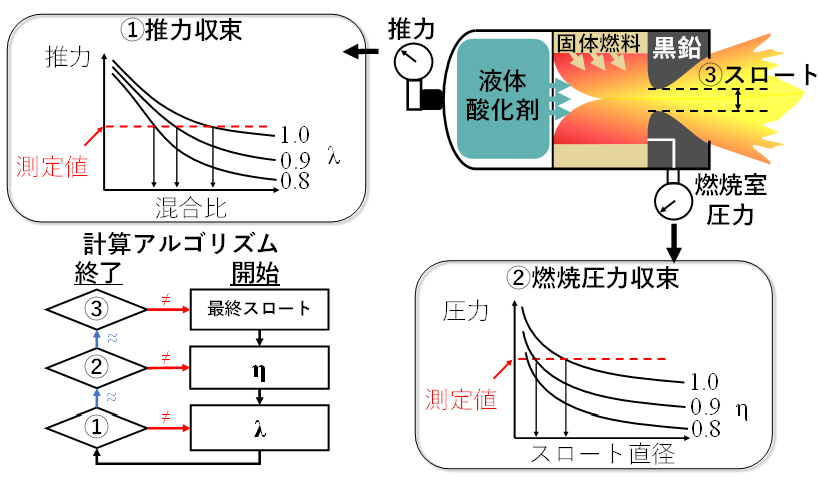 |
The mechanism proposed in our laboratory is explained here. The erosion of graphite nozzles used in hybrid rockets is thought to occur mainly through two processes.
(1) Diffusion of oxidants from the main stream to the nozzle wall due to the difference in concentration of oxidants between the nozzle wall and the main stream in the nozzle.
(2) C (carbon) in the nozzle wall reacts with the oxidants and is released as carbon monoxide.
From this mechanism, nozzle erosion can be thought of as a chemical kinetic-limited process in the initial phase of combustion and a diffusion-limited process in the subsequent phases. In other words, in the initial phase of combustion, the reaction between C and oxidants, etc., is less likely to occur because the nozzle wall temperature is small, and as combustion progresses, the reaction rate increases as the nozzle wall temperature rises. Therefore, in the initial stage of combustion, an important parameter that determines nozzle erosion is the nozzle wall temperature, and then, is replaced by the equivalent ratio O/F as the burning progresses.
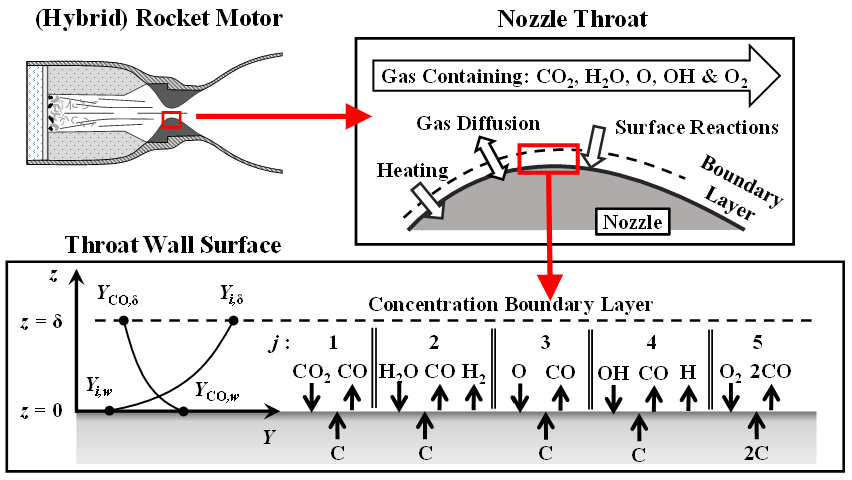 |






